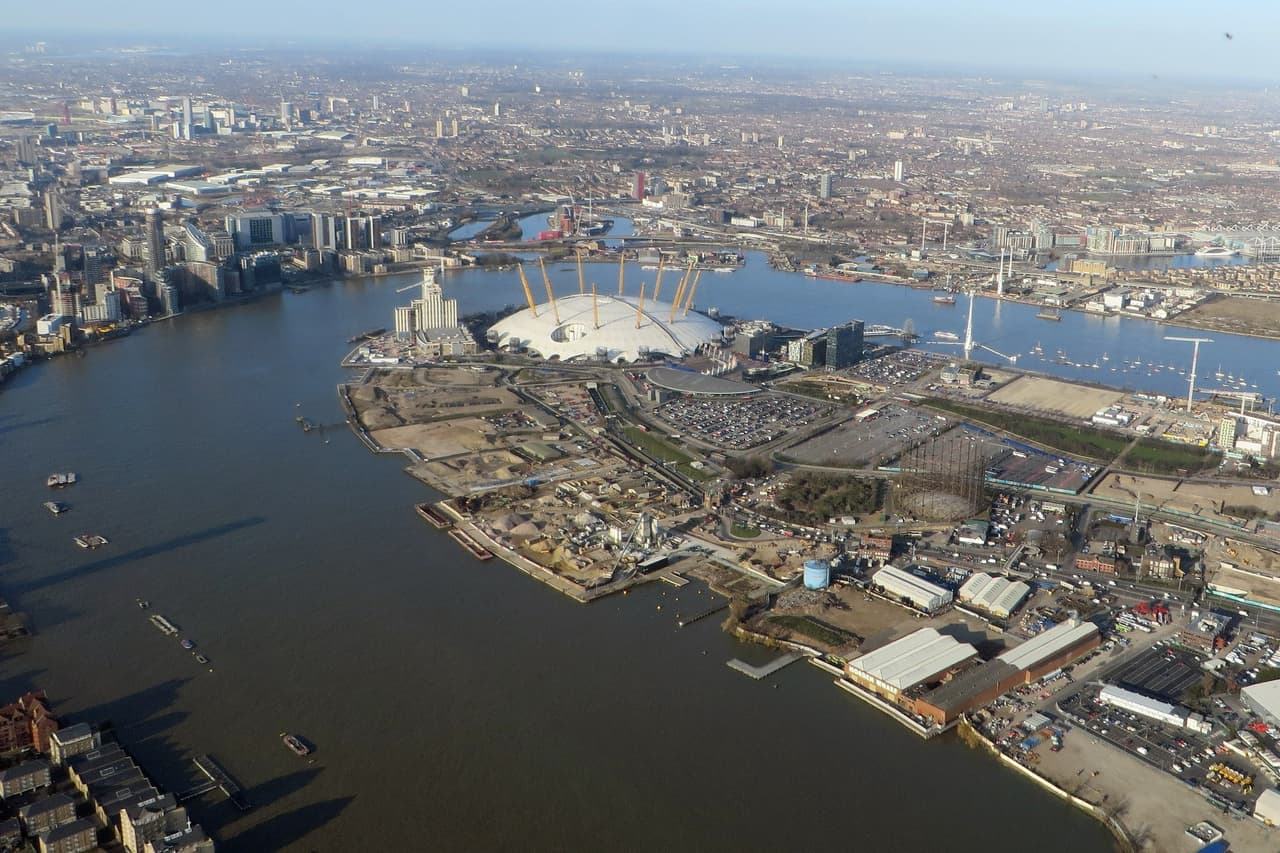
‘Dismay doesn’t do it justice’: How a secret system was used to axe hundreds of affordable homes
Greenwich peninsula: set for 15,000 new homes (pic: Diamond Geezer/Flickr)
In 2011, Shane Brownie, a chatty New Zealand-born 45-year-old, bought a brand new apartment close to one of Britain’s most iconic landmarks, the much-maligned Millennium Dome.
He moved to the windswept east of the Greenwich Peninsula, largely because he saw a good investment opportunity but also because he wanted to live in a mixed community.
Brownie was probably the sort of person Tony Blair had in mind when the then prime minister donned a hard hat during a visit to the Dome’s construction site in the late Nineties to set out a vision for the area.
This is where the Dome would be built; nearby a brand new London Underground station; and then on the rest of the 170 acres, a massive new housing development.
Taxpayers would spend hundreds of millions of pounds cleaning up toxic soil and extending the Jubilee London Underground line to the area.
In return, a substantial portion of the new homes would be affordable for ordinary Londoners.
Although the site sat on the banks of the Thames and overlooked the towers of Canary Wharf, this would not be an exclusive enclave for the rich.
Brownie was one who bought into the vision.
Yet just one year after he moved into City Peninsula – the first tower built on the strip – he grew concerned.
In June 2012, a company owned by Dr Henry Cheng Kar-Shun, the head of one of Asia’s richest families worth in excess of $20bn, bought 60% of the undeveloped part of the peninsula. A year later, his company Knight Dragon owned 100%.
The company’s ambition was to construct London’s “ultimate village”.
The site already had planning permission for 10,010 homes making it one of Europe’s biggest housing projects.
But there was one problem. As an information tribunal was to remark later, almost immediately after Knight Dragon acquired a controlling 60% stake in the site, the council was told on behalf of the developers that the scheme was no longer economically viable.
Greenwich council and London’s City Hall were told that the planning consent granted in 2004 had been negotiated in the midst of a housing boom. But following the bank crisis, the affordable homes target of 35% was now unrealistic.
To make it work now, the developers argued in January 2013 when house sale volumes were sluggish, the scheme would have to lose a large number of affordable homes.
If this wasn’t agreed, a promised £50m public subsidy for the build of the affordable homes was at risk and the numbers could be even worse.

The developers also said they wanted to move all affordable homes earmarked for river views to less attractive lower value areas of the peninsula.
So, as The Affordable Housing Crisis, a collaboration between Radio 4 and the Bureau reports, they submitted a formal financial viability assessment written by their advisers BNP Paribas Real Estate, to prove their case.
This assessment, affecting Knight Dragon’s first phase of 3,000 homes, was then cross-checked by Greenwich council and its consultant, Christopher Marsh.
Marsh produced his own report and this seemingly persuaded the council’s officials and politicians the developers were right.
And so at a council planning board meeting in February 2013 when, due to commercial confidentiality, neither report was produced to the committee in full detail, over 500 affordable homes were scrapped. This effectively meant the affordable homes target on the 3,000 properties was dropped from 35% to 21% and all moved to the least attractive part of the site.
Dismay and suspicion
“Dismay doesn’t do it justice,” Shane Brownie reflected.
Although at a time when housing waiting lists were rising, most people would have shrugged at what they regarded as an injustice and moved on.
But Brownie is by profession an expert housing researcher familiar with arcane British planning law. He wanted to understand on what basis this decision was made.
Brownie swiftly realised the 170-acre site had received £225m of public money decontaminating land poisoned by an enormous gasworks, and that a similar amount had been spent connecting the site to the London underground system.
He was also confused why Knight Dragon had gone through with the purchase in 2012 when any due diligence they were likely to have carried out could have highlighted concerns about profitability.
So in June 2013, Brownie submitted a simple Freedom of Information request to Greenwich council asking for the Paribas and Christopher Marsh reports.
After a fight of more than 18 months through various stages of appeal, he finally won.
Brownie’s victory for transparency could have implications for the way major development deals involving affordable housing are done and assessed, not only in booming London but also throughout the UK.
The Bureau has now analysed the two reports and our work suggests that Brownie could have been right to be wary of what some consider to be an opaque scrutiny process.
What are financial viability assessments?
The financial viability assessment is possibly the most contentious process in British housing. They are frequently submitted by developers when they want to go under a local authority’s affordable housing target – the proportion of affordable properties councils set, which typically range from 25% to 35% depending on housing demand, prices and wages in each area.
The affordable housing target is not a legally enforceable mechanism. It serves merely as guidance. It is trumped by national planning policy. This states that if a developer can prove building affordable homes makes a residential scheme financially unviable, the local authority’s target for low cost homes can be waived or reduced.
And they are increasingly common. Two years ago, the Bureau analysed over 80 developments in Britain’s 12 biggest cities and found 60% failing to meet local affordable housing targets.
But the crucial thing about these assessments is their contents are confidential. Often, not even councillors who have to make planning decisions are allowed to see them in full.
“Without transparency, how can we know whether the arguments made by developers are correct and fair,” noted Brownie.
Stamped across the front of the Paribas report is an assertion by the surveyors that their work is “private and confidential” and exempt from the Freedom of Information Act.
In February 2015, the First-Tier Tribunal, which rules on freedom of information appeals, disagreed. The Tribunal said: “This is a case where a company, robust enough to take on the development of a huge site over a period of 20 years, acquiring its interest in 2012 and increasing its share in 2013, immediately asks to be relieved of a planning obligation freely negotiated by its predecessor.
“It justifies this change on the basis of a downturn in house prices it knew about at the time of purchase, using a valuation model that looks at current values only and does not allow for change in the many factors that may affect a valuation over time. It seems to us that in those circumstances the public interest in openness about the figures is very strong.”
As a result we are now able to see the inner workings of the viability assessment.

What did Paribas say?
To calculate whether the Greenwich Peninsula scheme was viable, BNP Paribas Real Estate examined the state of the local housing market and ran their own calculations through a complex model.
On the bigger macroeconomic picture, they said Land Registry data indicated that while residential sale prices in Greenwich borough had “recovered well in mid-2010….this has not continued through into 2013. There is little indication that 2013 will see any significant further growth in prices as sales volumes remain at historically low levels.”
They then looked into the detail. Perhaps the most important inputs into the financial model were the sales prices that the developer believed it could fetch in current market conditions.
Predicting the exact per sq foot sales revenue months if not years before even foundations are dug is never going to be straightforward and precise. But this valuation is crucial. Especially as a tiny percentage increase on an average per sq ft value across thousands of units would mean either extra revenue of tens of millions of pounds for the developer or more affordable homes.
Developers Quintain, Knight Dragon’s 40% partner at the time of the report in January 2013, handed Paribas a range of prices for their private, non-affordable homes properties: £521-£671 per square foot.
Paribas “researched the local housing market through discussion with active local agents and through review of online internet resources”.
They concluded: “Through examining the comparable evidence collected we consider the assumption provided to us…as reasonable.”
They said the 3,000 units would generate total revenue of £1bn, but the costs, even allowing for 20% profit on each private sale and 6% on every sale of an affordable home, was not enough to justify the scheme going ahead with 35% of the scheme given over to affordable housing.
The only way the scheme could work, said the developers was to lose over 500 homes.
What the Bureau has done
An important question is how reasonable were the £521-£671 projected sales values used by Paribas in the model.
The Bureau conducted its own research using actual data from the closest comparable development.
We analysed the Land Registry sales data of 181 units at the nearby City Peninsula – the place where Brownie lives which was brought to the market in 2011.
We then established the size of those units using the Energy Certification Performance website.
This allowed us to calculate the per square foot valuation of each flat. We tracked the transactions over a four-year period.
Because the vast majority of the initial sales were in 2011, there is only a small set of data available in the following years from which we could calculate price growth.
However, our small sample suggests there was 6% price growth in 2012 and 7.6% growth in 2013.
Bureau analysis indicates that in 2014 average sales at City Peninsula were already averaging £670 per sq ft – the top of the range suggested by Knight Dragon back in January 2013.
Arguably, the Paribas figures were not unreasonable at the time they were submitted, although price growth in 2012 and through into 2013 at the Knight Dragon site might have been more likely than they concluded.
If this price growth was applied to Knight Dragon’s model, it could have resulted extra revenue worth tens of millions of pounds.
And previous Bureau research, reported last year, shows the housebuilding sector was recovering well in the UK in 2012: collectively, the UK’s top ten companies in the industry saw a near doubling of profits from £567m in 2011 to £1.1bn by 2012.
To Dr. Bob Colenutt, a housing expert at University of Northampton, evidence of house price growth on the peninsula could mean some of the affordable homes that were axed could have been saved. “A difference of 6-7% in prices is a large amount of money translated across this development and so the developer may well have been able to provide more affordable housing units,” he said.
Paribas declined to say whether it did similar in-depth analysis of City Peninsula properties.
In a statement, Knight Dragon said: “The viability assessment in 2013 was tested by independent consultants and agreed and accepted by the landowner (the GLA), the planning authority (the Royal Borough of Greenwich) and ourselves as developer.”
It added that prior to its involvement in the peninsula, just 60 affordable homes have been built.
Checks and balances
Another important question from a public scrutiny and transparency perspective is whether Greenwich council scrutinised the Paribas research to the fullest extent.
The Bureau has also seen the Marsh report, dated February 15 2013.
It was written over seven pages and gives much context and history of the site, and offers two tables showing how average house prices and monthly sales volumes in Greenwich in December 2012 were still well below their peaks in 2008 and 2006 respectively.
Marsh provided a further table showing that although annual volumes of sales in Greenwich in 2012 had recovered from the trough of the crash, they were still only half of what they were when planning consent for the scheme was granted in 2004. Marsh noted that was “a significant factor in the stalling of the project”.
He also explained that the potential loss of the £50m affordable housing grant was a “key driver” for the council. He said agreeing to Knight Dragon’s request would allow the developer to build high-end properties facing Canary Wharf on the river so that they would cross-subsidise the cheaper apartments further south.
Yet Marsh pointed out that the peninsula was entitled to a £50m housing grant from public funds to subsidise affordable housing. He also noted that schemes in Greenwich were achieving affordable housing rates of 20% without public subsidy. Even so, he recommended that Knight Dragon was justified in slashing to 21% its low cost housing.
However, the report did not contain any detailed discussion about crucial inputs into the Paribas model – the anticipated prices per square foot.
The Bureau asked Marsh whether he had carried out an exercise similar to ours and he declined to comment.
Greenwich council stated that it was driven to reach a deal to secure the £50m housing grant which otherwise would have expired.
It added its agreed 21% affordable rate on the 11 plots it agreed to reduce does not set a precedent for the rest of the peninsula.
It said values on “different sites” such as City Peninsula “cannot reliably be compared due to a number of different factors – from market conditions, to site specific costs – which can significantly vary.”
“Also the Planning Board can only go on information available at the time of its decision (Feb 2013) and what was predicted at that time – not what subsequently happened to property values after the decision had been taken. Clearly it’s welcome that the housing market has recovered to levels better than had been predicted at the start of 2013.”
Get ready for take off
It was Cheng’s father Cheng Yu-Tung who first built up the family fortune on the back of substantial Macau gambling interests, Asia’s largest listed jewellery business and huge real estate holdings.
Cheng’s ambition is not in doubt. Three months ago, Knight Dragon applied for permission to increase the number of homes on Greenwich Peninsula by 5,000, taking to the total to 15,000 in 35 high-rise towers.
A decision on the expansion is expected this autumn by Greenwich planners.
It is now almost 20 years since Tony Blair’s Labour government sold the nation his vision for Greenwich. Things didn’t quite go according to plan as the Dome failed to attract enough visitors and costs escalated wildly. The scale of public cash spent on the peninsula meant that when in 2002, the government gave the land away to private developers in return for a share of future profits, there was outrage.
Lord Falconer, the Labour minister in charge of the sale at the time, justified the move by saying up to £500m in profits would flow back to the Treasury once homes on the peninsula were sold. Falconer added that many of the thousands of homes built there would be affordable.
In the 13 years since Lord Falconer signed over the peninsula to developers, development has stalled and only £21.4m has flowed back to the public sector according to the GLA which is now in charge of the site.
It means there is pressure on the GLA and the local council to view the money that Knight Dragon has to invest in Greenwich as perhaps a final chance to finally build out the stalled project.
The big question will be how many affordable homes will the company commit to building?
The Bureau understands that Knight Dragon is prepared to make 25% of its bigger scheme to low cost housing. Some local politicians mutter they are determined to see the scheme contributing at least 30% – a difference of 750 units.
As things stand, it seems that Knight Dragon’s revised masterplan for 15,000 homes will fail to meet Greenwich’s 35% affordable housing target.
Knight Dragon said in a statement: “It would be premature to second guess the outcome of the full viability assessment for the new Masterplan application process, but we expect the exercise to be undertaken in good faith on both sides and to result in an outcome that achieves the twin objectives of commercial viability and maximum community benefit across all areas of provision.“
And despite the Information Tribunal’s ruling in February ordering the disclosure of the 2013 viability test, Knight Dragon still seemingly argues the commercial details of such documents should remain confidential.
It said: “Knight Dragon supports the principle of transparency and openness, but there are inevitably areas of commercial sensitivity. For instance, no business would wish to put fully into the public domain cost estimates for works that will in due course, become the subject of open market tenders.”
Transparency and disclosure
Knight Dragon may wish to keep confidential the financial projections it uses to justify any possible failure to meet Greenwich’s local affordable housing target. But events are moving fast.
Brownie’s triumph at an Information Tribunal hearing three months ago could have far reaching ramifications. Last week, Greenwich council confirmed its intention to ensure all financial viability tests are made public.
“This is about transparency for local people,” said Danny Thorpe, Greenwich council’s cabinet member for regeneration and transport.
All over London, councils are now considering following suit.
“They have little choice following that Information Tribunal ruling,” said one senior GLA official.
And senior figures inside the GLA have indicated to the Bureau that they believe the whole viability system needs to be overhauled and that they are currently considering alternatives.
For Shane Brownie, the issue is clear. “In my view, there have been fundamental problems with the lack of transparency of the decision making process in planning decisions such as this that have had a major impact on the future shape of local communities. It cannot be right that full viability evidence is not made available to the key people – even councillors – who have to make those decisions and to the community that have to live the consequences of those decisions.
“Too often, these negotiations are held behind closed doors and without any public consultation. This lack of transparency undermines full public confidence in the planning system. What we need is an open and transparent approach where decision makers and the community can see the facts to bring back confidence in the planning system.”




